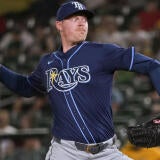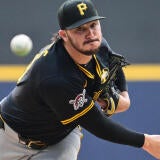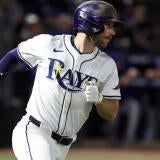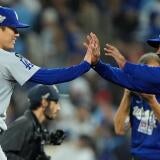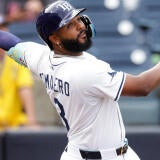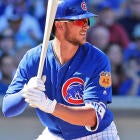Fantasy Baseball Stock Watch: Turnaround strategies; Ryu, Odorizzi and Bryant lead risers & fallers
With the season already a quarter over, it's time to consider rescue strategies for under-performing teams, plus we rate whose stock is on the way up, and whose is losing value.
We're at the quarter mark of the 2019 regular season, with teams having played anywhere from 37 to 43 games. The standings are beginning to make sense with none of last year's division winners is more than four games out of first place, and only two of last year's playoff teams -- surprises Oakland and Colorado -- are under .500. All six of the division leaders are teams that were expected to be in the hunt this season.
The standings in our Fantasy leagues should be beginning to make sense as well. While flukes are certainly possible, the teams toward the top of the standings are generally those filled with players who appear to be legitimate bargains, and the teams towards the bottom are generally those filled with long-term injuries and players who seem to have little hope of living up to their draft-day price.
What can we do in leagues where we fall into that unfortunate latter category? Rather than giving up on a team that sits at or near the bottom of the league, it's time to change your risk profile. There's generally no difference between finishing last and finishing in the first spot out of the money and/or playoffs, so if you're sitting third from the bottom, why not make some moves that are likely to make your team slightly worse but could send you shooting up the standings if everything breaks right?
Increasing your risk takes several forms. The most straightforward method is trading a known commodity for a more high-variance player, something worth approaching with an owner at the top of the standings who may be looking to lock in their position and decrease risk. Equally simple (and even easier to execute) is cutting a high-floor, low-ceiling player from the end of your roster to replace him with a minor-league stash.
There are other, less obvious paths available as well. Hitters in general are lower risk than pitching because pitchers have higher injury concerns but can also make sudden improvements seemingly out of nowhere if they figure out something with a new pitch or change up their pitch mix. Trading a hitter for a pitcher of equal value increases your risk, so a shift in focus could be what it takes to move up the standings, as you accept a small hit to your batting stats in exchange for the potential for a larger gain on the pitching side.
A similar strategy can be found with specific categories. The strikeout category, for example, is one in which it's not too hard to finish high in the standings simply by acquiring known high-strikeout arms, as a pitcher's strikeout rate is generally far more stable season-to-season than his ERA or win total. If you're low in the standings for pitching in general, it may be wise to shift focus into that category. If a strikeout pitcher is fairly priced, his downside risks in other stats will be built in, but that risk is something worth tolerating if you need to make a big move up the standings. Prioritizing strikeouts will usually have the desired effect in that category while being detrimental in other areas, but those are the risks we have to take if we're sitting at the bottom of the standings.
Risers
Ryu walked a batter Sunday against the Nationals for the first time since April 20. He also carried a no-hitter into the eighth inning and threw eight shutout frames, giving him one earned run in 25 innings in his last three starts. His 0.36 ERA over that stretch lowered his season mark from an already strong 2.96 to a very impressive 1.72. Most of his supporting stats aren't far off from last season – hardly a bad thing, as he recorded a 1.97 ERA in 15 starts in 2018 – but he's trimmed his walk rate from 4.6 percent to a ridiculous 1.6 percent. Durability remains a concern, as he's already made one trip to the injured list and hasn't made more than 25 starts since 2014, but there aren't many pitchers who are better on a per-start basis.
Odorizzi can certainly give Ryu a run for his money, as he hasn't given up a run in any of his last three starts, allowing 12 baserunners in 20 innings. A thoroughly average pitcher most of his career, the 29-year-old has trimmed his ERA to 2.32 through his first eight starts of the season, second among qualified American League starters. His .221 BABIP suggests some regression is in order, though he's always been a low BABIP guy, with a career .271 mark. His fastball velocity is up more than a tick to 92.4 mph, and his strikeout rate is up to a career-high 26.1 percent. Odorizzi will undoubtedly have some poor starts in his future, as his minuscule 3.8 percent HR/FB rate means he's yet to be punished for his very low 24.8 percent groundball rate, but there's enough to suggest he's better than the boring, interchangeable starter that he's been for the last several years.
Bryant struggled to a .217/.329/.350 line in his first 15 games, but he's turned things on since then, hitting .289/.450/.671 over his last 22 games. His .257 batting average on the season remains low for his standards, but it's easy to see that number continuing to rise if his .270 BABIP comes in line with his .340 career mark. He's demonstrating better plate discipline than ever, with his 16.6 percent walk rate and 17.2 percent strikeout rate each career highs. He's also making the best contact of his career, with career highs in exit velocity (90.0 mph) and barrel rate (11.5 percent). Don't let the slow start fool you – Bryant's numbers by the end of his age-27 season could be the best we've seen from him.
Like the rest of his Red Sox teammates, Rodriguez struggled out of the gate, allowing 11 earned runs in eight innings in his first two starts of the season. He's turned things around dramatically since, posting a 2.78 ERA in his past six starts. His 27.1 percent strikeout rate and 6.3 percent walk rate over that stretch would each represent career bests, and he's kept the ball on the ground at a 51.6 percent clip, well above his 38.7 percent mark from last season. The lefty's latest start was his best of the season, as he threw seven shutout innings against the Mariners on Friday. Durability concerns remain, as Rodriguez hasn't reached the 25-start mark in any of his four previous major league seasons, but he appears to be living up to his potential despite a 4.53 ERA on the season, which is still heavily affected by his two poor outings to start the year.
Brantley has an excellent .296 batting average over his 11-year career, but he generally hasn't been good for homer or steal totals higher than the mid-teens -- he's only reached 20 once in each category. Modest results in categories other than batting average (in addition to injury concerns) made Brantley the 73rd hitter off the board in the NFBC, but he's rewarded those who had faith in him this season, as he is the ninth most valuable hitter, according to our earned auction values. In his first season in Houston, he's combined a typically high .331 batting average with newfound power, as his 10 home runs are already halfway to his career high. His .482 expected slugging percentage is his best mark of the Statcast era, as is his 7.2 percent barrel rate, nearly double from last season. Brantley would hardly be the first player to reach a new level after joining the Astros, and he looks to be a top-tier outfielder for as long as he remains on the field.
Verdugo's value was hard to place during draft season because the lack of an obvious path to playing time gave him an NFBC ADP of 498.0 despite his clear talent. The 22-year-old was always going to be one injury away from a regular role, and that injury came early in the form of A.J. Pollock's elbow infection. Verdugo has since started 11 of the Dodgers' last 12 games, including five of six games against lefties. He's proved he belongs, with an excellent .343/.382/.569 line through 110 plate appearances. Those numbers are propped up somewhat by his .348 BABIP, but Statcast loves his quality of contact, giving him an expected batting average of .290. Verdugo has been limited to the back half of the Dodgers' batting order, featuring primarily in the sixth spot, but a continued hot streak could see him move up in the lineup and increase his value still further.
Fallers
There were plenty of reasons to like McHugh as he moved back into the starting rotation this season. In his previous four seasons as a starter from 2014 to 2017, he recorded a solid 3.69 ERA, with an unremarkable but perfectly acceptable 22.2 percent strikeout rate. Shifted to a relief role in 2018, he saw his strikeout rate soar to 33.2 percent while his ERA shrank to 1.99. Improving after moving to the bullpen is hardly unusual, but the gains were large enough to believe that McHugh would be better than ever as a starter this season. Instead, he's been booted back to the pen after struggling to 6.37 ERA through eight starts, including a 12.00 ERA over his last four. If his 56.9 percent strand rate and 21.4 percent HR/FB rate regress as expected, he could still have deep-league value in a long-relief role, but his appeal is gone in shallower formats unless he returns to the rotation quickly.
Minter looked to have a clear path to the closer role in Atlanta following Arodys Vizcaino's season-ending surgery in mid-April. Instead, he couldn't keep a major-league job in any form, let alone one as a closer, as he was optioned to Triple-A Gwinnett on Thursday after posting a 9.82 ERA in 11 innings. While he can undoubtedly blame a .469 BABIP for some of his struggles, it's tough to look past his very poor 15.3 percent walk rate. He could certainly figure things out in the minors and reclaim the role later in the year, but it's no longer possible to take it for granted that he has a long-term future as a high-leverage reliever. Even last season, when he recorded 15 saves with a 3.23 ERA, his 26.5 percent strikeout rate hardly screamed "shutdown closer."
Atlanta's lineup has improved with the addition of Josh Donaldson and growth from several young hitters, but that hasn't had a positive effect on Inciarte. After opening the season as the team's leadoff hitter, he's now locked into the eighth spot thanks to his .217/.296/.325 slash line. His struggles at the plate have prevented him from using his wheels on the basepaths, leaving him with just three steals (on pace for 11.9) after he recorded 28 last season. His supporting statistics are down across the board, with his 20.0 percent strikeout rate (up seven ticks from last season) the primary offender. He's never made particularly hard contact, but it's been worse than ever this season, as he has a career-low 79.9 mph exit velocity. One might think that Inciarte's defense would keep him in the lineup as he works through his struggles, but both DRS and UZR agree that he's taken a big step back there as well. It wouldn't be a surprise to see him lose playing time in the near future, with highly rated third-base prospect Austin Riley recently getting time in the outfield at the Triple-A level, presumably to take Inciarte's job.
It's a pleasant surprise that Andujar is playing at all after season-ending shoulder surgery appeared to be on the cards following the 24-year-old's torn labrum just three games into the season. Based on Andujar's 3-for-34 showing at the plate since returning from the injured list, it's not entirely clear that he should indeed be playing. His batted-ball data suggests that he's largely earned his miserable .128/.143/.128 season line -- his hard-hit rate has plunged to 24.3 percent while barrel rate is a nice round zero, the same number as his extra-base hit total. It's easy to believe at this point that his decision to return to action was misguided, and the Yankees have little reason to keep running him out there and risking further injury unless his performance improves dramatically. With the shoulder issue providing an obvious reason for his slump, it's hard to stomach leaving Andujar in a Fantasy lineup until he demonstrates that he's healthy and productive.


















